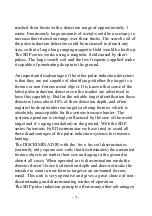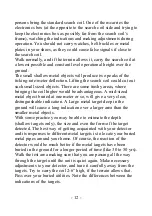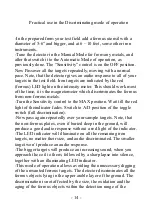
persons bring the standard search coil. One of them carries the
electronics box (at the opposite to the search coil side and trying to
keep the electronics box as possibly far from the search coil’s
frame), watching the indications and making adjustments during
operation. You should not carry watches, belt buckles or metal
plates in your shoes, as they could cause false signals if close to
the search coil.
Walk normally, and if the terrain allows it, carry the search coil at
a lowest possible and constant level operational height over the
ground.
The small shallow metal objects will produce two peaks of the
ticking-rate/meter deflection. Lifting the search coil could cut out
such small sized objects. There are some trashy areas, where
bringing the coil higher would be advantageous. A mid-sized
metal object buried at one meter or so, will give a very clear,
distinguishable indication. A Large metal target deep in the
ground will cause a long indication over a larger area than the
smaller metal objects.
With some practice you may be able to estimate the depth
(shallow targets only), the size and even the form of the target
detected. The best way of getting acquainted with your detector
and its responses to different metal targets is to locate your buried
metal pipes around your home. Of course, the reaction of the
detector would be much better if the metal targets have been
buried in the ground for a longer period of time (like 30 to 50 yrs).
Walk the test area making sure that you are passing all the way
through the target until the unit is quiet again. Make necessary
adjustments to your detector, and tune it carefully away from the
targets. Try to carry the coil 2-6” high, if the terrain allows that.
Pass over your buried utilities. Note the differences between the
indications of the targets.
- 12 -
Содержание DISCRIMINATOR
Страница 1: ...DISCRIMINATOR Pulse Induction Metal Detector SDP 2014A ...
Страница 22: ......
Страница 23: ......
Страница 24: ......










































